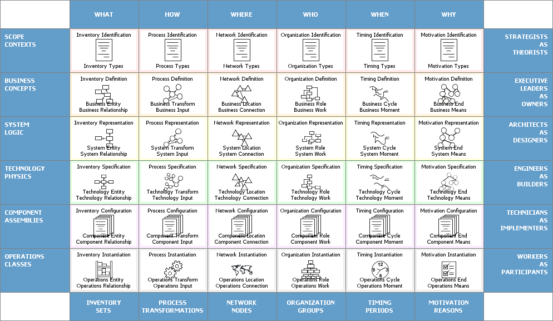Introduction
In the realm of enterprise architecture (EA), several frameworks and methodologies are available to guide organizations in effectively managing their IT infrastructure and aligning it with their business goals. Two of the most widely recognized and adopted frameworks in this domain are TOGAF (The Open Group Architecture Framework) and Zachman. While both frameworks aim to facilitate the creation and management of enterprise architectures, they differ in their approach, structure, and focus. In this comprehensive comparison, we will delve into the details of TOGAF and Zachman, highlighting their pros and cons, and explore which framework is better suited for specific use cases.
Overview of TOGAF
TOGAF, developed by The Open Group, is a widely adopted and comprehensive enterprise architecture framework. It provides a structured approach for designing, planning, implementing, and managing enterprise architectures. TOGAF is based on a modular structure and consists of various components and artifacts, including the Architecture Development Method (ADM), architectural content framework, and reference models. It focuses on the entire architecture development cycle, from initial concept to ongoing maintenance and governance.
Pros of TOGAF:
- Comprehensive Approach: TOGAF offers a holistic and comprehensive approach to enterprise architecture. It covers various aspects, including business architecture, data architecture, application architecture, and technology architecture, enabling organizations to develop cohesive and integrated architecture.
- Established Methodology: TOGAF provides a well-defined methodology called the Architecture Development Method (ADM). This methodology offers a step-by-step guide for developing enterprise architectures, ensuring consistency and a structured approach.
- Industry Standard: TOGAF is widely recognized and adopted as an industry standard for enterprise architecture. It has a large community of practitioners and a wealth of available resources, including training materials, certifications, and best practices, making it easier for organizations to adopt and implement the framework.
- Scalability and Flexibility: TOGAF is designed to accommodate organizations of different sizes and complexities. It provides a scalable, flexible framework tailored to organizational needs and requirements.
- Vendor-Neutral: TOGAF is vendor-neutral, which means it does not promote any specific technology or vendor. This neutrality allows organizations to make independent technology decisions and select solutions that best align with their business goals.
- Integration with Industry Standards: TOGAF integrates various industry standards, frameworks, and methodologies. This integration allows organizations to leverage existing practices and models, reducing duplication of efforts and enhancing interoperability.
Cons of TOGAF:
- Complexity: TOGAF, with its comprehensive nature, can be perceived as complex, especially for organizations new to enterprise architecture. The framework’s extensive documentation and the breadth of its components may require significant time and effort to understand and implement fully.
- Lack of Prescriptive Detail: While TOGAF provides a high-level methodology, it often lacks prescriptive detail on executing specific activities. This can leave practitioners struggling to translate the framework’s concepts into actionable plans.
- Adoption Challenges: Implementing TOGAF across an organization can be challenging. It requires organizational buy-in, dedicated resources, and a well-defined governance structure to ensure effective implementation and utilization of the framework.
Overview of Zachman
Zachman Framework, developed by John Zachman in the 1980s, is one of the earliest and most well-known enterprise architecture frameworks. The framework is based on a matrix structure consisting of six rows representing different perspectives (What, How, Where, Who, When, and Why) and six columns representing various stakeholders (Planner, Owner, Designer, Implementer, Operator, and Functioning Enterprise). The classification framework provides a taxonomy for organizing and structuring architectural artifacts.
Pros of Zachman:
- Structure and Clarity: The Zachman Framework offers a clear and structured taxonomy for organizing architectural artifacts. It provides a common language and framework for communication, facilitating better understanding and collaboration among stakeholders.
- Holistic View: The framework emphasizes the importance of multiple perspectives, enabling organizations to consider various dimensions and stakeholders’ viewpoints when developing architectures. This holistic view promotes alignment between business and IT, leading to more effective decision-making.
- Framework for Analysis: Zachman Framework is a powerful tool for analyzing existing architectures and identifying gaps and misalignments. It helps organizations assess their current state and define a target state, guiding them in planning and executing architectural transformations.
- Timeless Concepts: Despite being developed decades ago, the concepts and principles of the Zachman Framework remain relevant. The framework’s focus on the fundamental questions of what, how, where, who, when, and why provides a timeless perspective on enterprise architecture.
- Scalability and Applicability: The Zachman Framework can be applied to organizations of any size and across different industries. It is not limited to a specific domain or technology, making it versatile and adaptable to various contexts.
Cons of Zachman:
- Lack of Methodology: The Zachman Framework primarily focuses on the structure and organization of architectural artifacts and does not provide a detailed methodology for developing architectures. This lack of methodology can make it challenging for organizations to translate the framework into actionable plans.
- Limited Guidance on Implementation: While the framework provides a structure for organizing artifacts, it does not offer extensive guidance on implementation. Organizations may struggle to bridge the gap between the conceptual framework and the practical execution of architectural initiatives.
- Limited Scope: The Zachman Framework primarily focuses on the static representation of architecture artifacts and does not delve deeply into other aspects, such as governance, process, or change management. This limited scope may require organizations to supplement the framework with additional methodologies or frameworks to address these areas.
Which Framework is Better for Specific Use Cases?
Both TOGAF and Zachman have their strengths and weaknesses, making them suitable for different use cases within the enterprise architecture domain. The choice of framework depends on various factors, including the organization’s goals, complexity, and maturity level. Let’s explore some everyday use cases and which framework may be better suited for each:
Use Case: Comprehensive Enterprise Architecture Development
Recommendation: TOGAF
When organizations require a comprehensive and structured approach to developing and managing their enterprise architectures, TOGAF is the preferred choice. Its modular structure, well-defined methodology (ADM), and extensive coverage of architectural domains make it suitable for organizations looking for end-to-end guidance in architecture development.
Use Case: Analysis and Assessment of Existing Architectures
Recommendation: Zachman
The Zachman Framework is a valuable tool when organizations need to analyze and assess their existing architectures, identify gaps, and align them with business goals. Its taxonomy and focus on multiple perspectives enable organizations to analyze architectural artifacts from different angles, facilitating better understanding and decision-making.
Use Case: Governance and Compliance
Recommendation: TOGAF
TOGAF offers guidance in its Architecture Governance Framework (AGF) for organizations seeking a robust governance framework and compliance mechanisms. It provides a structured approach to establishing governance processes, roles, and responsibilities, ensuring architectural compliance and alignment with organizational objectives.
Use Case: Communication and Collaboration
Recommendation: Zachman
The Zachman Framework excels when organizations prioritize effective communication and collaboration among stakeholders. Structured taxonomy and common language facilitate clear communication, enabling stakeholders to understand and contribute to architectural discussions more effectively.
Use Case: Technology Selection and Vendor Neutrality
Recommendation: TOGAF
Organizations aiming for vendor-neutral technology selection and evaluation can benefit from TOGAF’s vendor-neutral stance. It allows organizations to make independent technology decisions based on their specific requirements without being biased toward any particular vendor or solution.
Conclusion
In conclusion, TOGAF and Zachman Framework offer valuable tools and perspectives for enterprise architecture development and management. TOGAF provides a comprehensive and modular approach, offering a structured methodology and extensive coverage of architectural domains. On the other hand, the Zachman Framework provides a structured taxonomy that promotes a holistic view and effective communication among stakeholders.
The choice between the two frameworks depends on the organization’s specific needs, goals, and maturity level in enterprise architecture. TOGAF is well-suited for organizations seeking a comprehensive, structured approach to developing end-to-end architecture. On the other hand, the Zachman Framework is ideal for organizations prioritizing effective communication, analysis of existing architectures, and alignment with business goals.
Ultimately, the decision to adopt either TOGAF or Zachman depends on understanding the strengths and weaknesses of each framework, considering the organization’s context, and aligning with its specific enterprise architecture objectives.




